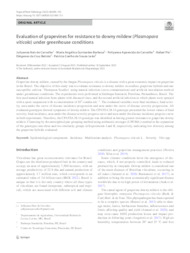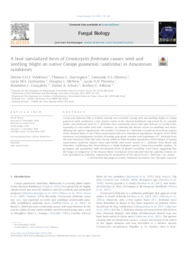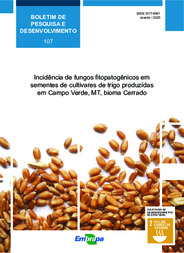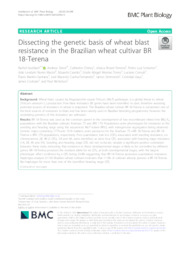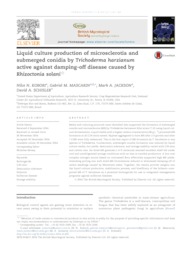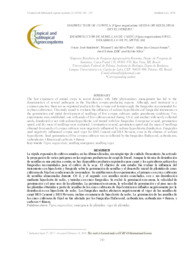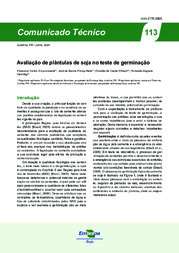Search Publications
Filter by:
| Author(s): CARVALHO, J. N. de; BARBOSA, M. A. G.; CARVALHO, P. A. de; PIO, R.; BATISTA, D. da C.; LEAO, P. C. de S. Grapevine downy mildew, caused by the fungus Plasmopara viticola is a disease with a great economic impact on grapevine in the Brazil. The objective of this study was to evaluate resistance to downy m... ... |
| Author(s): VALDETARO, D. C. O. F.; HARRINGTON, T. C.; OLIVEIRA, L. S. S.; GUIMARÃES, L. M. S.; MCNEW, D. L.; PIMENTA, L. V. A.; GONCALVES, R. C.; SCHURT, D. A.; ALFENAS, A. C. Ceratocystis fimbriata Ellis & Halsted recently was recorded causing seed and seedling blight on Carapa guianensis Aubl. (andiroba), a tree species native to the Amazon Rainforest and prized for its v... ... |
| Author(s): MACIEL, J. L. N.; GOUSSAIN, R de C. S.; CAVALHEIRO, J. N.; KOVALESKI, M.; CLEBSCH, C. C.; SBALCHEIRO, C. C.; SILVA, D. da; DEUNER. C. C. Resumo: A análise sanitária de sementes de trigo é um importante procedimento para avaliação da qualidade das mesmas. Dependendo do patógeno encontrado e de sua taxa de infecção, ações como o tratamen... ... |
| Dissecting the genetic basis of wheat blast resistance in the Brazilian wheat cultivar BR 18-Terena. Author(s): GODDARD, R.; STEED, A.; CHINOY, C.; FERREIRA, J. R.; SCHEEREN, P. L.; MACIEL, J. L. N.; CAIERAO, E.; TORRES, G. A. M.; CONSOLI, L.; SANTANA, F. M.; FERNANDES, J. M. C.; SIMMONDS, J.; UAUY, C.; COCKRAM, J.; NICHOLSON, P. Background: Wheat blast, caused by Magnaporthe oryzae Triticum (MoT) pathotype, is a global threat to wheat (Triticum aestivum L.) production. Few blast resistance (R) genes have been identified to da... ... |
| Author(s): SAWAZAKI, H. E.; SA, L. A. N. de; GONÇALVES, C. R. N. C. B.; VEIGA, R. F. A.; COLOMBO, C. A. Abstract: Aiming at optimizing the diagnosis of major sugarcane diseases by PCR, primers were developed (scald, orange rust) and amplified fragments according to the literature were used as positive c... ... |
| Author(s): SILVA, C. E. da; GHINI, R. The objective of this work was to evaluate the effects of increased air‑CO2 concentration on plant growth and on leaf‑spot caused by Cylindrocladium candelabrum in Eucalyptus urophylla. Se... ... |
| Author(s): KOBORI, N. N.; MASCARIN, G. M.; JACKSON, M. A.; SCHISLER, D. A. Media and culturing protocols were identified that supported the formation of submerged conidia and microsclerotia (MS) by Trichoderma harzianum Rifai strain T-22 using liquid culture fermentation. Li... ... |
| Author(s): OLIVEIRA, P. G. de; QUEIROZ, M. A. de; LIMA NETO, I. da S.; CASTRO, J. M. da C. e; OLIVEIRA, R. S. de Guava decline is a complex disease caused by the interaction between Meloidogyne enterolobii and Neocosmospora falciformis (Syn.: Fusarium solani). Thus, selecting M. enterolobii-resistant genotypes w... ... |
| Author(s): SMIDERLE, O. J.; SILVA NETO, M. L.; SOUZA, A. das G.; ZILLI, J. E.; SILVA, K. da The fast expansion of annual crops in recent decades with little phytosanitary management has led to the dissemination of several pathogens in the Brazilian cowpea-producing regions. Although, seed tr... ... |
| Author(s): KRZYZANOWSKI, F. C.; FRANÇA-NETO, J. B.; OHLSON, O. de C.; HENNING, F. A.
|
Observation
Some of Embrapa's publications are published as ePub files. To read them, use or download one of the following free software options to your computer or mobile device. Android: Google Play Books; IOS: iBooks; Windows and Linux: Calibre.
Access other publications
Access the Agricultural Research Database (BDPA) to consult Embrapa's full library collection and records.
Visit Embrapa Bookstore to purchase books and other publications sold by Embrapa.

